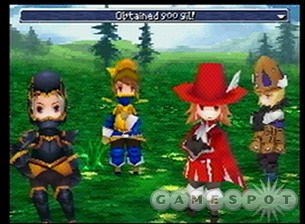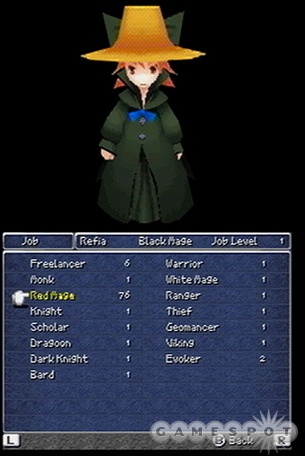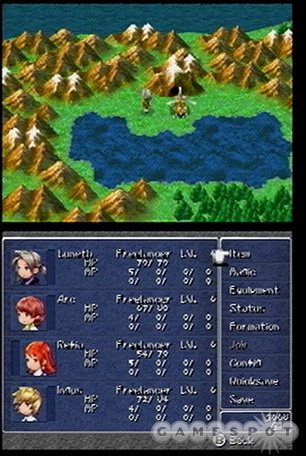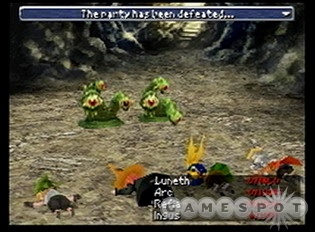If you're a longtime Final Fantasy player, then the first thing that probably comes to mind when you think of Final Fantasy III is the classic 1994 role-playing game for the Super Nintendo Entertainment System. However, it's now widely known that this was, in fact, the sixth game in the series; it was published at a time when developer Square was muddling up the numbering conventions between Japan and North America, since several Final Fantasy chapters that came out in Japan never made it stateside. Now there's finally a proper English-language version of the real Final Fantasy III, which was originally published for the Famicom in 1990, the very same year that the very first Final Fantasy game arrived in North America for the Nintendo Entertainment System. Of course, this is hardly just a straight port of the original game, thanks to a completely overhauled presentation. With its attractive new look, Final Fantasy III feels like a whole new game. Its gameplay and storyline may seem conventional by today's standards, but in another sense, a game like this goes to show how little role-playing games have evolved over the past 15 years or so.

Those who've followed the Final Fantasy series will instantly recognize that this game's distinctive character design is a spitting image of 1999's excellent Final Fantasy Tactics, with the difference being that this game is fully 3D. The doll-like player characters of Final Fantasy III are terribly cute and sharply contrasted by the relatively realistic-looking variety of monsters they'll frequently encounter. This visual style, while very different from the pixelated 2D sprites from the 8-bit Nintendo days, still is faithful to the spirit of the early games in the series, which also pitted cute little warriors and magic users against nasty-looking enemies several times their size. More importantly, the game looks and sounds impressive on the Nintendo DS, between its detailed 3D graphics and its unmistakably Final Fantasy musical score.
The presentation does have a couple of minor downsides, unfortunately. The game doesn't move as smoothly as its 2D counterparts, which hampers the pacing of combat as well as simple acts like bringing up the character menu screen. And Final Fantasy III all but completely neglects the DS's top screen, which is blank most of the time during play. You get a map while exploring the overworld, but you're on your own in the game's various dungeons. This isn't that big of a deal, but it seems awfully strange that you don't get so much as a pretty picture to look at up there.
The Final Fantasy series is known for featuring completely new worlds, storylines, and characters from one installment to the next, with certain overarching themes and gameplay elements tying every game together. Final Fantasy III shows a lot of these common themes in their purest form. The plot is simple: An orphaned boy named Luneth discovers a magical crystal, which informs him that he's got an important, save-the-world type of job to do. Early on, he's joined by a shy friend named Arc, a spunky blacksmith's daughter named Refia, and a guardsman named Ingus. Together, they set off to discover the secrets of the four elemental crystals hidden around the world, and in so doing, they learn a few surprises about the world itself. They'll meet and travel with some supporting characters along the way. One of the differences between this version of Final Fantasy III and the original is that the main characters now have clearly defined personalities, and they're a likable lot. The game's dialogue is written well enough, and the simple story works to compel you to brave tougher and tougher challenges.

Remember when role-playing games were all about random monster encounters, leveling up, finding new loot, and exploring different towns and dungeons? Oh, wait. In any case, Final Fantasy III originally helped make the mold in the first place. However, Final Fantasy fans will note a few key differences in this game's combat system. This is true turn-based combat, not the "active time battle" system of later Final Fantasies. So at the beginning of a battle, you get to give orders to each of your party members and then watch as those orders are resolved; statistics determine the order in which your characters and their opponents act. A combination of weapon attacks, damaging black magic spells, and restorative white magic spells, plus some items and special abilities, are the keys to success. Some foes will use status-altering effects to throw you off, or they may be particularly vulnerable to certain types of damage.
You'll learn some of this the hard way through trial and error, because the game can be quite tough in a few spots. There aren't save points, either, as you're limited to permanently saving your progress on the world map; as a result, you're going to run into cases where you've fought all the way through a hard dungeon, only to get wiped out by the boss waiting for you at the end, and then having to start over from your last save. However, even those particularly difficult boss fights are nothing that typically can't be solved by an hour or two of random encounters and leveling up.

What distinguishes Final Fantasy III's combat system and overall gameplay is the job system, which first appeared in this installment of the series and was later used by games like Final Fantasy V, Final Fantasy Tactics, and Final Fantasy XI. The job system in this particular game isn't quite as flexible or open-ended as in some of the later Final Fantasies, but it's still a lot of fun to play around with, especially since changing one of your character's jobs causes his or her outfit to completely change with it. There's something undeniably appealing about seeing one of your little party members go from wearing, say, the head-to-toe armor of a dragoon, to the pointy hat of a black mage, to the cloak and spectacles of a scholar.
There are more than 20 different job types in all, and you gain access to more of them the further you get in the game. Some are inherently stronger than others, and you'll naturally want to balance out your party with a variety of jobs. But you're free to play around with the system as you wish. Final Fantasy III doesn't let you mix and match skills from different job types like some of the later games do, and it also forces you to slog through a few fights after changing jobs before you start gaining experience in that job, which is separate from your character's overall experience level. As a result, you might feel discouraged to change jobs unless it seems necessary. However, the job system still helps make the combat much more interesting than it would have been if you were stuck with the same basic characters throughout the whole experience.
The combat has some other interesting points that are worth mentioning, which seem rooted in how Final Fantasy once drew influence from Dungeons & Dragons. For example, your characters gain an increasing number of melee attacks per turn as they gain experience, and you're free to equip weapons in each of their hands. It's not long before that monk of yours can be dishing out flurries of 10 or more punches in a single round. The magic system is a little different from later Final Fantasy games, as well. Every spell has a certain spell level, and your casters can use a certain number of spells from a given level, based on their overall experience. Having these types of nuances to the gameplay helps make Final Fantasy III feel different from other recent RPGs.

This is a pretty long game that can last you a few dozen hours or more, as there are optional dungeons to explore and powerful foes to face, if you're still up for more and more battles and better gear after you're finished with the main quest. Final Fantasy III also includes rudimentary Wi-Fi support through a system that lets you exchange letters with other players, a process that eventually rewards you with some exclusive items. You can get letters from some of the in-game characters, as well.
Final Fantasy III is a fine example of a video game remake done properly. Its presentation is top-notch for a Nintendo DS game, and the classic RPG combat is interesting and deep enough to still hold up well to today's standards. Final Fantasy fans should particularly enjoy tracing some of the roots of their favorite games from the series back to this installment, while taking in all of its new sights and sounds. But just about anyone looking for a traditional role-playing game to take with them on the go should find a lot to like in Final Fantasy III.



